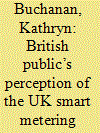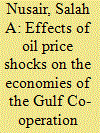|
|
|
Sort Order |
|
|
|
Items / Page
|
|
|
|
|
|
|
| Srl | Item |
| 1 |
ID:
150892


|
|
|
|
|
| Summary/Abstract |
The traditional energy utility business model is under pressure, and energy services are expected to play an important role for the energy transition. Experts and scholars argue that utilities need to innovate their business models, and transform from commodity suppliers to service providers. The transition from a product-oriented, capital-intensive business model based on tangible assets, towards a service-oriented, expense-intensive business model based on intangible assets may present great managerial and organizational challenges. Little research exists about such transitions for capital-intensive commodity providers, and particularly energy utilities, where the challenges to servitize are expected to be greatest. This qualitative paper explores the barriers to servitization within selected Swiss and German utility companies through a series of interviews with utility managers. One of them is ‘asset transformation’, the shift from tangible to intangible assets as major input factor for the value proposition, which is proposed as a driver for the complexity of business model transitions. Managers need to carefully manage those challenges, and find ways to operate both new service and established utility business models aside. Policy makers can support the transition of utilities through more favorable regulatory frameworks for energy services, and by supporting the exchange of knowledge in the industry.
|
|
|
|
|
|
|
|
|
|
|
|
|
|
|
|
| 2 |
ID:
150863


|
|
|
|
|
| Summary/Abstract |
Consumer acceptance of smart meters remains crucial in achieving the potential carbon emission reductions offered by advanced metering infrastructures. Given this, the present research used deliberative focus groups to examine what is needed to secure acceptance and engagement from domestic consumers with services, products and ‘offers’ in smarter power systems. Our findings suggest that consumers are able to identify not just threats relating to smart metering initiatives but opportunities as well. In particular, our focus group participants responded positively to the idea of an automated system that could be used to achieve energy savings in combination with time-of-use tariffs. We conclude by outlining suggestions for policy recommendations that may help consumer acceptance of smart meter enabled services be more readily achieved.
|
|
|
|
|
|
|
|
|
|
|
|
|
|
|
|
| 3 |
ID:
150887


|
|
|
|
|
| Summary/Abstract |
China's manufacturing industries are traditionally energy-intensive sectors and are responsible for over half of the country's total CO2 emissions. In this paper, we propose a global meta-frontier non-radial directional distance function approach to measure the CO2 emissions performance of Chinese manufacturing sectors during the period of 1990–2012. This approach allows us to simultaneously consider technological heterogeneity in manufacturing, non-radial slacks, and undesirable outputs. The global level of environmental technology is incorporated into the efficiency model to improve discriminating power and comparability. The results indicate significant differences in CO2-emissions-reduction performance among five broad groups of Chinese manufacturing industries. The “global technologies/ innovators group” is the most efficient under meta-frontier technologies, with the smallest technology gap. Meanwhile, the “energy-/resource-intensive commodities group” is, on average, the least efficient. Therefore, the Chinese government should implement targeted policies that encourage firms in the global technologies/innovators group to increase market share while supporting those in the energy-/resource-intensive commodities group to upgrade their technologies.
|
|
|
|
|
|
|
|
|
|
|
|
|
|
|
|
| 4 |
ID:
150883


|
|
|
|
|
| Summary/Abstract |
Cities play a vital role in the global climate change mitigation agenda. City population density is one of the key factors that influence urban energy consumption and the subsequent GHG emissions. However, previous research on the relationship between population density and GHG emissions led to contradictory results due to urban/rural definition conundrum and the varying methodologies for estimating GHG emissions. This work addresses these ambiguities by employing the City Clustering Algorithm (CCA) and utilizing the gridded CO2 emissions data. Our results, derived from the analysis of all inhabited areas in the US, show a sub-linear relationship between population density and the total emissions (i.e. the sum of on-road and building emissions) on a per capita basis. Accordingly, we find that doubling the population density would entail a reduction in the total CO2 emissions in buildings and on-road sectors typically by at least 42%. Moreover, we find that population density exerts a higher influence on on-road emissions than buildings emissions. From an energy consumption point of view, our results suggest that on-going urban sprawl will lead to an increase in on-road energy consumption in cities and therefore stresses the importance of developing adequate local policy measures to limit urban sprawl.
|
|
|
|
|
|
|
|
|
|
|
|
|
|
|
|
| 5 |
ID:
150894


|
|
|
|
|
| Summary/Abstract |
Du and Lin (2015) argued that the estimation model of the economy-wide energy rebound effect proposed by Shao et al. (2014) should be revised and provided an alternative approach, which they considered to be more consistent with the definition of the rebound effect. However, in this comment, we do not find a valid correction or modification to our original model, because their criticism logic does not originate from the corresponding mechanism in Shao et al. (2014), and their estimation formula has a different benchmark with ours. Moreover, their data samples were also different from ours, generating the incomparable results, and there are some irrational results in the comment. Even based on different estimation formulas in the two studies and using the same estimation method and data sample, the comparison results show that the problem of the estimation formula in our previous study which they claimed does not really exist. We argue that this comment is not consistent with the principle of the rebound effect. Actually, their work can be only regarded as proposing an alternative approach for the estimate of the rebound effect. Therefore, their argument is not enough to overturn our previous study.
|
|
|
|
|
|
|
|
|
|
|
|
|
|
|
|
| 6 |
ID:
150890


|
|
|
|
|
| Summary/Abstract |
This paper investigates the spatial dynamics of per capita carbon dioxide (CO2) emissions in China. The analyses are conducted by employing a continuous dynamic distribution approach and panel data of 286 cities at the prefecture and above-prefecture level. The results show that per capita CO2 emissions tend to converge during the sample period of 2002–2011. However, multimodality is found in the ergodic distribution of the full sample. It is also found that there is more persistence in cities with low per capita CO2 emissions, and more mobility in cities with high per capita CO2 emissions. The analyses also show that the dynamics of per capita CO2 emissions are significantly different among various geographical, income and environmental policy groups. The conditional distribution analyses indicate that multimodality cannot be explained independently by any one of the two factors, namely geographical location or income level. The findings in this study may have important policy implications for CO2 abatement in China.
|
|
|
|
|
|
|
|
|
|
|
|
|
|
|
|
| 7 |
ID:
150869


|
|
|
|
|
| Summary/Abstract |
The profitability of nuclear power plant investment is largely determined by the construction duration, which directly impacts discounted cash flows, debt and interest payments, as well as variable costs, such as labor. This paper analyzes the key drivers of construction duration using survival models. We focus especially on the strategic expectation formation of private and public utilities engaging in such highly risky megaprojects. Using a balanced dataset of explanatory variables and the IAEA/PRIS dataset of reactor construction starts between 1950 and 2013 we find that the expectation of rising oil prices and higher economic growth, along with the higher per capita GDP of a country tend to reduce the time needed to grid connection. We also identify the reactor models with the fastest construction duration.
|
|
|
|
|
|
|
|
|
|
|
|
|
|
|
|
| 8 |
ID:
150893


|
|
|
|
|
| Summary/Abstract |
This paper examines the effects of oil price shocks on the real GDP of the Gulf Cooperation Council (GCC) countries. The empirical method used is the nonlinear cointegrating autoregressive distributed lag (NARDL) model of Shin et al. (2013) in which short-run and long-run nonlinearities are introduced via positive and negative partial sum decompositions of the explanatory variable(s). The results suggest evidence of asymmetries in all the cases. We find significant positive oil price changes in all the cases with the expected positive sign, implying that increases in oil price lead to increases in real GDP. Conversely, negative oil price changes are significant for only Kuwait and Qatar with the expected positive sign, suggesting that decreases in oil price lead to decreases in their real GDP. Further analysis implemented using panel data shows that positive oil prices changes increase real GDP and negative changes decrease real GDP. Overall, the results suggest that positive oil price changes have a considerably larger impact on real GDP than negative changes.
|
|
|
|
|
|
|
|
|
|
|
|
|
|
|
|
| 9 |
ID:
150866


|
|
|
|
|
| Summary/Abstract |
Policy makers presently lack access to quantified estimates – and hence an explicit understanding – of energy consumption efficiency within households, creating a potential gap between true efficiency levels and the necessarily assumed efficiency levels that policy makers adopt in designing and implementing energy policy. This paper attempts to fill this information gap by empirically quantifying electricity consumption efficiency for a sample of more than 7,000 households. Adopting the recently introduced ‘frontier demand function’ due to Filippini and Hunt (2011) but extending it into the metafrontier context – to control for structural heterogeneity arising from location type – it is shown that consumption efficiency is little more than 60% on average. This implies huge potential for energy reduction via the expansion of schemes to promote energy efficiency. City households, which are the wealthiest in the sample, are shown to define the metafrontier demand function (and hence have the potential to be the most efficient households), but at the same time exhibit the largest inefficiencies. These facts together allow for a potential refinement on the household energy ladder concept, suggesting that wealth affords access to the best technologies thereby increasing potential energy efficiency (the ‘traditional view of the household energy ladder), but complementary to this these same households are most inefficient. This has implications for numerous areas of policy, including for example the design of energy assistance schemes, identification of energy education needs/priorities as well more refined setting of subsidies/tax-credit policies.
|
|
|
|
|
|
|
|
|
|
|
|
|
|
|
|
| 10 |
ID:
150870


|
|
|
|
|
| Summary/Abstract |
Following liberalization reforms, the ability of power markets to provide satisfactory incentives for capacity investments has become a major concern. In particular, current energy markets can exhibit a phenomenon of investment cycles, which generate phases of under and over-capacity, and hence additional costs and risks for generation adequacy. To cope with these issues, new mechanisms, called capacity remuneration mechanisms (CRM), have been (or will be) implemented. This paper assesses the dynamic effects of two CRMs, the capacity market and the strategic reserve mechanism, and studies to what extent they can reduce the investment cycles. Generation costs and shortage costs of both mechanisms are also compared to conclude on their effectivity and economic efficiency. A simulation model, based on system dynamics, is developed to study the functioning of both CRMs and the related investment decisions. The results highlight the benefits of deploying CRMs to solve the adequacy issue: shortages are strongly reduced compared to an energy-only market. Besides, the capacity market appears to be more beneficial, since it experiences fewer shortages and generation costs are lower. These comparisons can be used by policy makers (in particular in Europe, where these two CRMs are mainly debated) to determine which CRM to adopt.
|
|
|
|
|
|
|
|
|
|
|
|
|
|
|
|
| 11 |
ID:
150878


|
|
|
|
|
| Summary/Abstract |
Building sector consumes a significant amount of energy worldwide (up to 40% of the total global energy); moreover, by the year 2030 the consumption is expected to increase by 50%. One of the reasons is that the performance of buildings and its components degrade over the years. In recent years, energy benchmarking for government office buildings, large scale public buildings and large commercial buildings is one of the key energy saving projects for promoting the development of building energy efficiency and sustainable energy savings in Gulf Cooperation Council (GCC) countries. Benchmarking would increase the purchase of energy efficient equipment, reducing energy bills, CO2 emissions and conventional air pollution. This paper focuses on energy benchmarking for shopping centers in Gulf Coast Region. In addition, this paper will analyze a sample of shopping centers data in Gulf Coast Region (Dubai, Ajman, Sharjah, Oman and Bahrain). It aims to develop a benchmark for these shopping centers by highlighting the status of energy consumption performance. This research will support the sustainability movement in Gulf area through classifying the shopping centers into: Poor, Usual and Best Practices in terms of energy efficiency. According to the benchmarking analysis in this paper, the shopping centers best energy management practices in the Gulf Coast Region are the buildings that consume less than 810 kW h/m2/yr, whereas the poor building practices are the centers that consume greater than 1439 kW h/m2/yr. The conclusions of this work can be used as a reference for shopping centres benchmarking with similar climate.
|
|
|
|
|
|
|
|
|
|
|
|
|
|
|
|
| 12 |
ID:
150889


|
|
|
|
|
| Summary/Abstract |
The biomass sector has a strategic role in energy renewables policy, according to the National Renewable Energy Action Plans (NREAPs), elaborated in compliance with the Directive 2009/28/EC. Planning a suitable use of biomass for energy purposes call for the clear definition of the biomass potential, that has to be periodically updated by inventories for all EU countries.
|
|
|
|
|
|
|
|
|
|
|
|
|
|
|
|
| 13 |
ID:
150888


|
|
|
|
|
| Summary/Abstract |
This paper applies a panel of 28 provinces of China from 1996 to 2012 to study the impacts of economic development, energy consumption, trade openness, and urbanization on the carbon dioxide, waste water, and waste solid emissions. By estimating a dynamic panel model with the system Generalized Method of Moments (GMM) estimator and an autoregressive distributed lag (ARDL) model with alternative panel estimators, respectively, we find that the Environmental Kuznets Curve (EKC) hypothesis is well supported for all three major pollutant emissions in China across different models and estimation methods. Our study also confirms positive effects of energy consumption on various pollutant emissions. In addition, we find some evidence that trade and urbanization may deteriorate environmental quality in the long run, albeit not in the short run. From policy perspective, our estimation results bode well for Chinese government's goal of capping greenhouse emissions by 2030 as outlined in the recent China-US climate accord, while containing energy consumption and harm effects from expanding trade and urbanization remains some environmental challenges that China faces.
|
|
|
|
|
|
|
|
|
|
|
|
|
|
|
|
| 14 |
ID:
150867


|
|
|
|
|
| Summary/Abstract |
The share of wind generation in the Irish and British electricity markets is set to increase by 2020 due to renewable energy (RE) targets. The United Kingdom (UK) and Ireland have set ambitious targets which require 30% and 40% of electricity demand to come from RE, mainly wind, by 2020, respectively. Ireland has sufficient indigenous onshore wind energy resources to exceed the RE target, while the UK faces uncertainty in achieving its target. A possible solution for the UK is to import RE directly from large scale onshore and offshore wind energy projects in Ireland; this possibility has recently been explored by both governments but is currently on hold. Thus, the aim of this paper is to estimate the effects of large scale wind energy in the Irish and British electricity markets in terms of wholesale system marginal prices, total generation costs and CO2 emissions. The results indicate when the large scale Irish-based wind energy projects are connected directly to the UK there is a decrease of 0.6% and 2% in the Irish and British wholesale system marginal prices under the UK National Grid slow progression scenario, respectively.
|
|
|
|
|
|
|
|
|
|
|
|
|
|
|
|
| 15 |
ID:
150868


|
|
|
|
|
| Summary/Abstract |
The share of wind generation in the Irish and British electricity markets is set to increase by 2020 due to renewable energy (RE) targets. The United Kingdom (UK) and Ireland have set ambitious targets which require 30% and 40% of electricity demand to come from RE, mainly wind, by 2020, respectively. Ireland has sufficient indigenous onshore wind energy resources to exceed the RE target, while the UK faces uncertainty in achieving its target. A possible solution for the UK is to import RE directly from large scale onshore and offshore wind energy projects in Ireland; this possibility has recently been explored by both governments but is currently on hold. Thus, the aim of this paper is to estimate the effects of large scale wind energy in the Irish and British electricity markets in terms of wholesale system marginal prices, total generation costs and CO2 emissions. The results indicate when the large scale Irish-based wind energy projects are connected directly to the UK there is a decrease of 0.6% and 2% in the Irish and British wholesale system marginal prices under the UK National Grid slow progression scenario, respectively.
|
|
|
|
|
|
|
|
|
|
|
|
|
|
|
|
| 16 |
ID:
150879


|
|
|
|
|
| Summary/Abstract |
Fuel poverty and cold housing constitute a significant public health problem. Energy efficiency interventions, such as façade retrofitting, address the problem from a structural and long-term perspective. Despite evidence of the health benefits of insulation, little is known about the political and social contexts that contribute to social inequalities in receiving and experiencing health benefits from these interventions. We used a realist review methodology to better understand the mechanisms that explain how and why variations across different social groups appear in receiving energy efficiency façade retrofitting interventions and in their impact on health determinants. We considered the four stages of the policy implementation framework: public policy approach; policy; receiving intervention and impact on health determinants. We found strong evidence that certain social groups (low-income, renters, elderly) suffering most from fuel poverty, experience more barriers for undertaking a building retrofitting (due to factors such as upfront costs, “presentism” thinking, split incentives, disruption and lack of control), and that some public policies on housing energy efficiency may exacerbate these inequalities. This can be avoided if such policies specifically aim at tackling fuel poverty or social inequities, are completely free to users, target the most affected groups and are adapted to their needs.
|
|
|
|
|
|
|
|
|
|
|
|
|
|
|
|
| 17 |
ID:
150873


|
|
|
|
|
| Summary/Abstract |
This study provides a detailed case study assessment of two business sites in the UK, to understand the policy drivers of increases to their energy costs and energy bills, considering all current UK energy and climate change policies. We compare our findings to more generalised, theoretical calculations of the policy cost impact on energy costs and bills – we have found no other studies as comprehensive as ours in terms of policy coverage.
We find that for one site the government has over-estimated the likely energy savings due to energy efficiency options. Such differences in estimates should be taken into account when considering the efficacy of climate change policies on future energy savings. The overall impact of energy and climate change policies on costs will be of the order 0.4% of total business costs by 2020. This provides an important metric for the near-term cost of mitigation to meet longer-term climate change goals.
|
|
|
|
|
|
|
|
|
|
|
|
|
|
|
|
| 18 |
ID:
150859


|
|
|
|
|
| Summary/Abstract |
This study assessed global onshore wind power resources considering the distance to urban areas in terms of transmission losses and costs, and visibility (landscape impact) restrictions. Including this factor decreased the economic potential considerably depending on the level of supply cost considered (at least 37% and 16% for an economic potential below 10 and 14 US cents/kWh, respectively). Its importance compared to other factors was secondary below 15 US cents/kWh. At higher costs it was secondary only to land use, and was more important than economic and technical factors. The impact of this factor was mixed across all regions of the world, given the heterogeneity of wind resources in remote and proximal areas. Regions where available resources decreased the most included the European Union, Japan, Southeast Asia, the Middle East, and Africa. The supply cost chosen to evaluate the economic potential and uncertainties influencing the estimation of distance to the closest urban area are critical for the assessment. Neglecting the restrictions associated with integration into energy systems and social acceptability resulted in an overestimation of global onshore wind resources. These outcomes are fundamental for global climate policies because they help to clarify the limits of wind energy resource availability.
|
|
|
|
|
|
|
|
|
|
|
|
|
|
|
|
| 19 |
ID:
150861


|
|
|
|
|
| Summary/Abstract |
The existing literature on the construction costs of nuclear power reactors has focused almost exclusively on trends in construction costs in only two countries, the United States and France, and during two decades, the 1970s and 1980s. These analyses, Koomey and Hultman (2007); Grubler (2010), and Escobar-Rangel and Lévêque (2015), study only 26% of reactors built globally between 1960 and 2010, providing an incomplete picture of the economic evolution of nuclear power construction. This study curates historical reactor-specific overnight construction cost (OCC) data that broaden the scope of study substantially, covering the full cost history for 349 reactors in the US, France, Canada, West Germany, Japan, India, and South Korea, encompassing 58% of all reactors built globally. We find that trends in costs have varied significantly in magnitude and in structure by era, country, and experience. In contrast to the rapid cost escalation that characterized nuclear construction in the United States, we find evidence of much milder cost escalation in many countries, including absolute cost declines in some countries and specific eras. Our new findings suggest that there is no inherent cost escalation trend associated with nuclear technology.
|
|
|
|
|
|
|
|
|
|
|
|
|
|
|
|
| 20 |
ID:
150891


|
|
|
|
|
| Summary/Abstract |
Refurbishment, as part of the construction industry, has a strong global impact, not only from the viewpoint of economies but also from social and energy-efficiency perspectives. A thermal refurbishment process, in particular, involves numerous decisions and choices; the decision-makers being ultimately confronted with two major questions: which criterion should be adopted in the choice of the refurbishment construction solutions and which refurbishment construction solutions should be chosen?
|
|
|
|
|
|
|
|
|
|
|
|
|
|
|
|
|
|
|
|
|